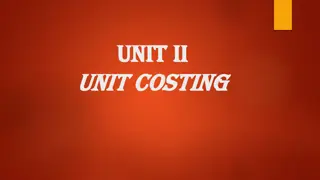Understanding Marginal Costing in Cost Accounting
Marginal Costing is a cost analysis technique that helps management control costs and make informed decisions. It involves dividing total costs into fixed and variable components, with fixed costs remaining constant and variable costs changing per unit of output. In Marginal Costing, only variable costs are considered in production costs, and Break-even Analysis is an essential aspect. This method values finished goods and work-in-progress at marginal costs and distinguishes fixed costs as period costs and variable costs as product costs. Ultimately, it aids in determining selling prices based on marginal cost plus contribution.
Download Presentation

Please find below an Image/Link to download the presentation.
The content on the website is provided AS IS for your information and personal use only. It may not be sold, licensed, or shared on other websites without obtaining consent from the author. Download presentation by click this link. If you encounter any issues during the download, it is possible that the publisher has removed the file from their server.
E N D
Presentation Transcript
Marginal Costing Subject: CostAccounting Class: B Com VI Semester
Marginal Costing Marginal Costing is a specific technique of cost analysis in which cost informations are presented in such a manner so that it may help the management in cost control and various managerial decisions.
Concept of Marginal Cost According to ICMA London, Marginal cost is the amount at any given volume of output by which aggregate cost are changed if the volume of output is increased or decreased by one unit.
Some Important Points In this technique, total cost is divided into fixed and variable components. Fixed expenses remain aggregate amount and do not vary with the increase or decrease in production upto a particular level of output. On the other hand, variable expenses increase or decrease in proportion to increase or decrease in output and remain constant per unit of output. constant in
Some Important Points Fixed expenses lead to different costs per unit at different levels of production. it means, fixed cost decreases per unit with the increase in production and increases per unit with the decrease in production. Marginal cost is used in two meanings. According to first meaning marginal cost refers to variable cost. Variable cost consists of direct materials, direct labour, variable direct expenses and all variable overheads.
Some Important Points Marginal Cost = Prime Cost + All Variable Overheads Marginal Cost = Direct Material + Direct Labour + Direct Expenses Marginal Cost = Total Cost All Fixed Overheads Marginal Cost= Total Cost-(Fixed Works Expenses + Fixed Office Expenses+ Fixed Selling & Distribution Expenses)
Basic Characteristics of Marginal Costing It is a technique of Cost Analysis and Presentation which helps management in taking various management decision. The stocks of finished goods and work-in-progress are valued at Marginal costs. Fixed cost is treated as period cost, whereas variable cost is regarded as a cost of product. All elements of cost are classified into Fixed and Variable. Selling price is determined on the basis of marginal cost plus contribution. In Marginal Costing, only variable costs are charged to production cost. Break-even Analysis is an integral part of Marginal Costing.























